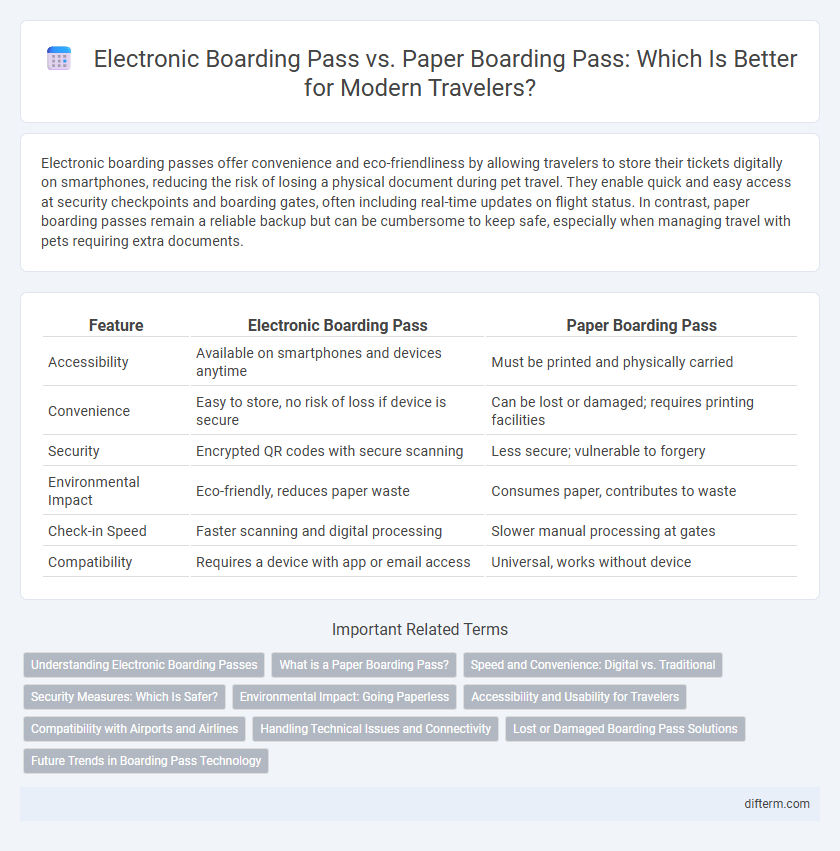Electronic boarding passes offer convenience and eco-friendliness by allowing travelers to store their tickets digitally on smartphones, reducing the risk of losing a physical document during pet travel. They enable quick and easy access at security checkpoints and boarding gates, often including real-time updates on flight status. In contrast, paper boarding passes remain a reliable backup but can be cumbersome to keep safe, especially when managing travel with pets requiring extra documents.
Table of Comparison
| Feature | Electronic Boarding Pass | Paper Boarding Pass |
|---|---|---|
| Accessibility | Available on smartphones and devices anytime | Must be printed and physically carried |
| Convenience | Easy to store, no risk of loss if device is secure | Can be lost or damaged; requires printing facilities |
| Security | Encrypted QR codes with secure scanning | Less secure; vulnerable to forgery |
| Environmental Impact | Eco-friendly, reduces paper waste | Consumes paper, contributes to waste |
| Check-in Speed | Faster scanning and digital processing | Slower manual processing at gates |
| Compatibility | Requires a device with app or email access | Universal, works without device |
Understanding Electronic Boarding Passes
Electronic boarding passes store passenger information digitally, accessible via smartphones or smart devices, eliminating the need for physical paper. They enhance convenience by allowing quick scanning at security checkpoints and boarding gates, reducing wait times and streamlining airport processes. Digital passes also offer real-time updates on flight status and gate changes, improving overall travel experience.
What is a Paper Boarding Pass?
A paper boarding pass is a physical ticket issued by airlines that allows passengers to board their flight, containing essential flight details such as passenger name, flight number, departure time, and gate information. Unlike electronic boarding passes stored on smartphones or other devices, paper boarding passes must be printed prior to travel and presented at security checkpoints and boarding gates. Airlines vary in their use of paper boarding passes, with some still offering them as a backup or for passengers without mobile devices.
Speed and Convenience: Digital vs. Traditional
Electronic boarding passes streamline passenger flow by enabling quick access through mobile devices, reducing wait times at security and boarding gates. Paper boarding passes, while reliable, demand physical handling and can slow down the process due to printing errors or misplacement. Mobile boarding passes also offer real-time updates and seamless integration with airline apps, enhancing overall travel convenience.
Security Measures: Which Is Safer?
Electronic boarding passes offer enhanced security measures by minimizing the risk of loss or theft compared to paper boarding passes, which can be physically misplaced or stolen. Digital passes often incorporate encrypted QR codes and require authentication via mobile devices, reducing the chance of counterfeiting. Advanced security features in electronic boarding systems improve passenger verification while maintaining privacy and data protection standards.
Environmental Impact: Going Paperless
Electronic boarding passes significantly reduce paper consumption, lowering deforestation and waste production in the travel industry. By eliminating the need for physical tickets, airlines minimize carbon emissions associated with printing and transport logistics. Choosing paperless boarding helps travelers contribute to sustainable travel practices by reducing the overall environmental footprint of their journeys.
Accessibility and Usability for Travelers
Electronic boarding passes offer enhanced accessibility by allowing travelers to access their boarding information directly on smartphones or wearable devices, reducing the risk of loss or damage that paper passes face. Usability improves as digital passes can be easily updated with real-time flight information and integrate with airport security systems for faster scanning. Paper boarding passes, while universally accepted and not reliant on device battery life, can be less convenient due to the need for physical handling and vulnerability to wear and tear during travel.
Compatibility with Airports and Airlines
Electronic boarding passes enhance compatibility with a wider range of airports and airlines due to their digital format, allowing seamless integration with mobile devices and airport security systems. Many airlines and airports now prioritize or exclusively accept electronic boarding passes, reducing the risk of printing errors and lost documents. Paper boarding passes remain necessary in limited cases where digital infrastructure is unavailable or for passengers preferring physical copies, but their use is steadily declining as technology adoption increases globally.
Handling Technical Issues and Connectivity
Electronic boarding passes streamline airport navigation but rely heavily on smartphone functionality and internet connectivity, which can pose challenges during technical malfunctions or weak signals. Paper boarding passes provide a reliable backup when digital devices fail or battery life is depleted, ensuring uninterrupted access to flight credentials. Travelers should consider downloading offline digital passes or printing physical copies to mitigate connectivity issues and technical glitches.
Lost or Damaged Boarding Pass Solutions
Electronic boarding passes reduce the risk of losing or damaging the pass since they are stored on mobile devices or cloud platforms, allowing easy retrieval anytime. Airlines often provide quick reissue options via apps or customer service kiosks, minimizing travel disruptions compared to paper passes. Digital formats enable seamless scanning and verification, enhancing security and convenience during airport check-ins and boarding procedures.
Future Trends in Boarding Pass Technology
Electronic boarding passes are rapidly replacing paper boarding passes due to increased convenience, enhanced security features, and environmental sustainability. Biometric integration and mobile wallet compatibility are key future trends in boarding pass technology, enabling seamless, contactless airport experiences. Airlines and airports are investing in AI-driven systems to personalize traveler journeys and reduce check-in time through smart boarding passes.
electronic boarding pass vs paper boarding pass Infographic

 difterm.com
difterm.com